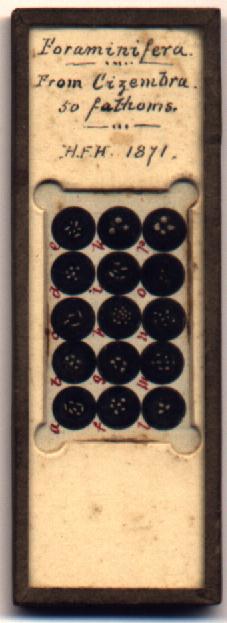THE
INVESTIGATION OF A MICROSCOPE SLIDE. |
 I suppose
most people would freely call microscopy an educational
activity, although there are those who would plead that their
interest lies more in the area of aesthetic appreciation than
in pure science. The following 2 scans at 150 dots per inch,
depict a very old slide that has survived the years extremely
well and if subjected to reasonable environmental conditions
is actually good for another 100 years. But we may ask who
made it? When was it made? Where was it made? What is it
constructed of and where was the material gathered?
I suppose
most people would freely call microscopy an educational
activity, although there are those who would plead that their
interest lies more in the area of aesthetic appreciation than
in pure science. The following 2 scans at 150 dots per inch,
depict a very old slide that has survived the years extremely
well and if subjected to reasonable environmental conditions
is actually good for another 100 years. But we may ask who
made it? When was it made? Where was it made? What is it
constructed of and where was the material gathered?
Being a mounter of Foraminifera, the source
of material has to come first, so that I may go and do
likewise!
'Cizembra'.
First I consulted several good world
gazetteers with no success at all. This problem is not new!
Cizembra sounds Slavic or perhaps Italian to the English ear
but is it? Could it be in the East of Europe where names have
changed with politics?
Then I opened up an online search machine on the World Wide
Web and came up with an answer from a Roman Catholic
information office in New York.
Under the heading of St. Machutus
(Maclovius, Malo) (ref. 2): an article described how the
Saint, born in 520AD, had followed St Brendon on his epic
journey from Llancarrven with many followers to the
"Island of the Blest" and then on a second voyage
they went off to "The Island of September " known
as Cizembra offshore from the French town of St. Malo. I
presume that the word is Celtic. If one looks up the online
tourist map of the area in French there it lies! The clearest
map of offshore St. Malo came from a Britsh Nautical Almanac
of the Channel coast.
'H.F.H'
But who is H.F.H. ? If you are a keen
Quekett member you may be able to guess. Here Dr.
Bracegirdle's new book (ref. 1) on "Microscopical
Mounts and Mounters" more than answered several of
the remaining questions. H.F.H are the initials of none other
than Henry F. Hailes 1827-1892, a draftsman, and founder
member of the QMC, also one time editor of the QMC Journal
and vice president of the Society. He is given credit with
having mounted Foraminifera during the 1880's which included
laid slides.(ref. 3). Henry does not seem to have produced
any written work on the Foraminifera but he did write some
curious and more general articles in the early Journals of
the QMC.
The Cell.
That leaves us with the information on the cell and the background. The preparation is in too good a condition to dissect so we shall have to be satisfied with examination by hand lens. The cell is perhaps cut from 1mm card and a similar thick white card provides a base. The slight irregularities in the black mounting areas can not be blamed on the computer! I suspect that these were created on a ringing table. I would imagine that since Hailes was a draughtsman he probably outlined the little circles with a small compass before ringing with black in order to make them more or less equal in area. The coverglass looks like a 1mm 3x1 inch slide which has been taped on. If we turn the slide over, a species list has been drawn up on a label in the style of the 1880's. These are certainly temperate species of the North Atlantic.
Comments to the author Brian
Darnton welcomed.

Label on the underside of the slide.
REFERENCES.
1. Brian Bracegirdle "Microscopical Mounts and Mounters" ISBN 0-9514441-3-1. Published by the Quekett Microscopical Club, London, 1998.
2. The Catholic Encyclopedia - http://www.newadvent.org/cathen/09503a.htm
3. The CD-ROM Edition of The Journal of the
Quekett Microscopical Club 1868-1992,
Under 'Members, Authors and Obituary'. Published
1998 by the QMC.
Editor's notes:
A Micscape review of Brian Bracegirdle's excellent book can
be found here,
and a review of the CD-ROM Edition of the QMC Journal here. Details
of the CD-ROM set including purchasing can be found on the
QMC website below.
The informative web site of the Quekett Microscopical Club is at http://www.nhm.ac.uk/hosted_sites/quekett/. Membership is open to microscopists worldwide.
Microscopy UK Front Page
Micscape Magazine
Article Library
© Microscopy UK or their contributors.
Published in the January 2000 edition of Micscape Magazine.
Please report any Web
problems or offer general comments to the Micscape Editor,
via the contact on current Micscape Index.
Micscape is the on-line
monthly magazine of the Microscopy UK web
site at Microscopy-UK